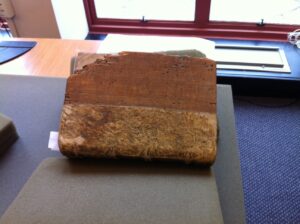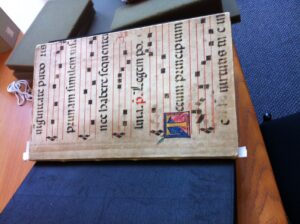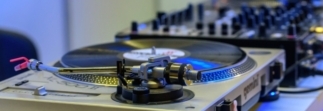By MIT Libraries’ student blogger, Pri Tembhekar
Hello everyone!
I had the pleasure of visiting the Archives Reading Room (14N-118) and seeing some of MIT’s rare books. During my “behind-the-scenes” tour of some of the Libraries’ special collections, Stephen Skuce, Program Manager for Rare Books, kindly showed me some of his favorite rare pieces. MIT Libraries acquire rare books primarily through gifts from friends and alumni of MIT. Many of the books are related to the history of science and technology and thus were especially interesting to me as an engineer.
We started by looking at Gregor Reisch’s Margarita Philosophica (Basel, 1508 – MIT Vail Collection). As you can see from the photo, part of the appeal of these books is their aesthetic. They are preserved very carefully (more on that next week) in order to retain their character and wear that is significant as to how they were used. The Margarita Philosophica is an early encyclopedia, filled with knowledge considered important at the time. Interestingly, it contains one of the earliest relatively correct drawings of human internal anatomy.
Even more interesting, in my opinion, were the anatomically incorrect depictions of various animals in Conrad Gessner’s Icones Animalium Quadrupedum (Zurich, 1553 – MIT Kelly Collection). While some common animals such as cows were accurate, others such as camels and unicorns were less realistic. It was mesmerizing to see a bit of history so well preserved, and right under my nose nonetheless!
Particularly relevant to my engineering background were William Gilbert’s De Magnete (London, 1600 – MIT Vail Collection) and Robert Boyle’s New Experiments Physico-mechanical, Touching the Spring of the Air (Oxford, 1662 – MIT Vail Collection). These early works on magnetism and chemistry were at the frontlines of the science of their times. Their contributions remain relevant to me as a student interested in the energy applications of chemical engineering.
My favorite piece among those Stephen pulled for my visit was Jane Marcet’s Conversations on Chemistry (London, 1807 – MIT Rogers Collection). It was my favorite in part because of the beautiful story Stephen shared with me about Jane Marcet. Despite the obstacles that women faced in getting an education, Marcet learned a great deal of chemistry. She passed it on in a very approachable book. The book is simply a dialogue of two girls asking their teacher questions about chemistry and her answers. It became an inspiration to girls and boys interested in science, including Michael Faraday.
Finally, if you are wondering how rare books are useful beyond simply being fascinating, the case of Mamusse Wunneetupanatamwe (The Eliot Bible) (Cambridge, Mass., 1685 – MIT Kelly Collection) is a great example. This bible was translated into an Algonquin language so that Christianity could be taught to Native Americans living in the Massachusetts region. This language has since disappeared since it was not written by any of its native speakers. However, MIT scholars were able to use The Eliot Bible along with an English version of the bible to revive the language. Thanks again to Stephen Skuce for the tour!






